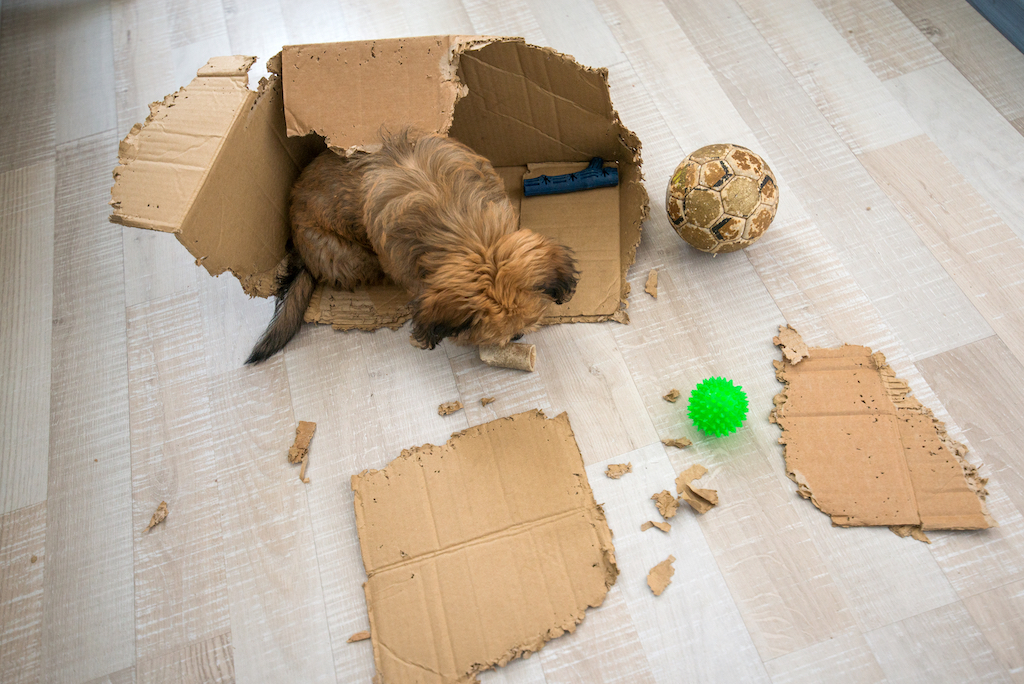Imagine this: you walk through the door after a tiring day at work, longing for the comforting presence of your beloved furry companion. But instead, you’re greeted by a chaotic scene – your once well-behaved dog has turned into a destructive force, leaving behind a trail of destruction and confusion.
As pet owners, we all know that dogs can have their moments of mischief. However, when this behavior becomes sudden and frequent, it can be alarming and even hazardous.
In this blog post, we’ll delve into the topic of “sudden destructive behavior in dogs” and unravel its possible causes, warning signs to look out for, preventive measures to take, and steps to address it if it occurs.
Throughout this post, we’ll explore:
- The underlying factors that may trigger sudden destructive behavior
- How to recognize early indicators
- Practical tips for preventing such behavior
- Expert insights from veterinarians and dog trainers
- Effective strategies to manage and redirect destructive tendencies
Join us as we navigate through this common yet perplexing issue faced by many dog owners. Let’s equip ourselves with knowledge and understanding to better care for our canine companions.
Examples of destructive dog behavior
Table of Contents
Dogs exhibit a wide range of destructive behaviors, from chewing and digging to excessive barking and separation anxiety. To effectively address and prevent these behaviors, owners must provide suitable outlets for their dog’s innate instincts.
This includes offering chew toys and designated areas for digging. Moreover, dogs also require ample physical and mental stimulation to keep them satisfied.
Gradually introducing them to periods of alone time can help prevent separation anxiety. If necessary, seeking guidance from a professional trainer or behaviorist can be beneficial as well.
Additionally, addressing any underlying medical conditions and maintaining a consistent routine are crucial in preventing destructive behavior in dogs.
What causes destructive behavior?
Dogs can exhibit sudden destructive behavior for a variety of reasons, such as medical issues, separation anxiety, attention-seeking, fear, and boredom.
As a dog owner, it is vital to comprehend these underlying causes and take appropriate measures to prevent further destructive behavior.
| Underlying Causes | Signs and Indicators | Suggested Actions |
|---|---|---|
| Medical Problems | – Unusual chewing or scratching patterns – Constant pacing or restlessness – Changes in eating or bathroom habits |
If suspected, it is best to consult a veterinarian for diagnosis and treatment. |
| Separation Anxiety | – Destructive actions when left alone – Excessive barking or whining – Attempts to escape confinement |
Gradual desensitization and counterconditioning techniques can be helpful, as well as seeking advice from a certified animal behaviorist. |
| Attention Seeking | – Destructive behavior when ignored – Vocalization or jumping – Biting or nipping |
Ignoring the behavior and redirecting their attention to a more appropriate activity can reduce attention-seeking tendencies. |
| Fear | – Destructive behavior when exposed to certain triggers – Cowering or hiding – Aggressive behaviors towards people or other animals |
Gradual desensitization and counterconditioning techniques, along with seeking guidance from a certified animal behaviorist, can help address fear-related behaviors. |
| Boredom | – Destructive behavior when left alone for extended periods – Excessive chewing or digging at furniture or household items – Restlessness or hyperactivity |
Providing ample exercise and mental stimulation through interactive toys, training, and daily walks can help alleviate boredom and prevent destructive behaviors. |
It is important to note that some dogs may also exhibit destructive behavior due to obsessive-compulsive disorder, age-related cognitive decline, or breed tendencies. In such cases, seeking guidance from a certified animal behaviorist is highly recommended.
How to stop destructive dog behavior
There are numerous effective approaches that dog guardians can employ to prevent and halt destructive conduct in their canine companions. These methods incorporate:
| 1. | Ensure sufficient physical activity and mental stimulation: | Dogs require regular physical activity and mental stimulation to maintain their happiness and well-being. Make sure your dog receives enough exercise through daily strolls, runs, or playtime. Mental stimulation can be provided through training, puzzle toys, or games. |
| 2. | Supervise your dog: | When leaving your dog alone at home, ensure they are in a secured and confined area. This will prevent them from engaging in destructive behaviors such as chewing on furniture or getting into household items that could harm them. |
| 3. | Provide appropriate outlets for destructive behavior: | Dogs have an innate instinct to chew and dig. Provide them with suitable toys or chew bones to redirect this behavior towards acceptable objects. |
| 4. | Tackle separation anxiety: | If your dog exhibits destructive behaviors when left alone, it may be a sign of separation anxiety. Seek advice from a professional trainer or behaviorist to address this issue and help your dog feel more comfortable when alone. |
| 5. | Identify and treat any underlying medical conditions: | If you suspect your dog’s destructive behavior is due to a medical issue, consult with your veterinarian to rule out any potential health problems. Treating the underlying condition can help alleviate the destructive behavior. |
| 6. | Maintain a consistent routine and environment: | Dogs thrive on consistency and stability. Try to maintain a consistent routine and environment for your dog to minimize stress and anxiety. |
| 7. | Provide obedience training: | Teaching your dog basic obedience commands such as “sit,” “stay,” and “leave it” can help instill discipline and prevent destructive behaviors. It also strengthens the bond between you and your dog. |
| 8. | Reinforce positive behaviors: | Reward your dog for good behavior with praise, treats, or playtime. This will encourage them to continue exhibiting positive behaviors. |
By incorporating these techniques, dog guardians can effectively prevent and stop destructive conduct in their furry friends. It is crucial to remember that dogs are intelligent creatures and often engage in destructive behaviors due to boredom, lack of stimulation, or underlying issues.
When to get professional help for your dog
| When to Get Professional Help for Your Dog | Recognizing Signs of Destructive Behavior |
| Excessive Chewing/Destruction of Household Items | While it’s normal for puppies and young dogs to chew on things, adult dogs who exhibit destructive chewing may have underlying issues such as separation anxiety or boredom. As a responsible owner, it’s important to recognize this behavior and seek professional help. |
| Persistent Destructive Behavior Despite Training and Discipline | If your dog continues to engage in destructive behaviors despite consistent training and discipline, it could be a sign of deeper behavioral issues that require the expertise of a professional. Don’t wait until it becomes a bigger problem – seek help early on. |
| Aggressive Behavior Towards People or Other Animals | Dogs that become aggressive when stopped from destroying items or exhibit aggression towards other animals may have underlying behavioral issues that require professional attention. It’s crucial to address this behavior before it escalates. |
| Changes in Eating Habits/Sudden Weight Loss | Stress or anxiety can cause changes in appetite and weight loss, which can manifest as destructive behaviors in dogs. If you notice these changes, it’s important to consult with a professional to address any underlying issues. |
| Harm to Themselves or Others | If your dog’s destructive behavior is causing harm to themselves or others, immediate professional help should be sought. Don’t wait for the problem to escalate – take action to ensure the safety of your pet and those around them. |
As a responsible dog owner, it’s crucial to keep an eye out for these signs of destructive behavior.
By recognizing them early on and seeking professional help, you can address any underlying issues and ensure a happier and healthier life for your beloved pet.
Also Read: Why Does My Dog Grunt When I Hug Him?
Conclusion
In conclusion, the sudden destructive behavior of dogs can be a distressing and perplexing experience for pet owners. It is essential to understand the underlying causes and recognize warning signs in order to address this issue effectively.
By providing appropriate outlets for their instincts, regular exercise and mental stimulation, and seeking professional help when necessary, we can manage and redirect destructive tendencies in our furry friends.
It is crucial to remember that dogs are intelligent creatures with complex emotions. Their behavior may be a result of underlying medical conditions or stressors that require attention.
As responsible owners, it is our duty to provide proper care and attention to our beloved companions.






